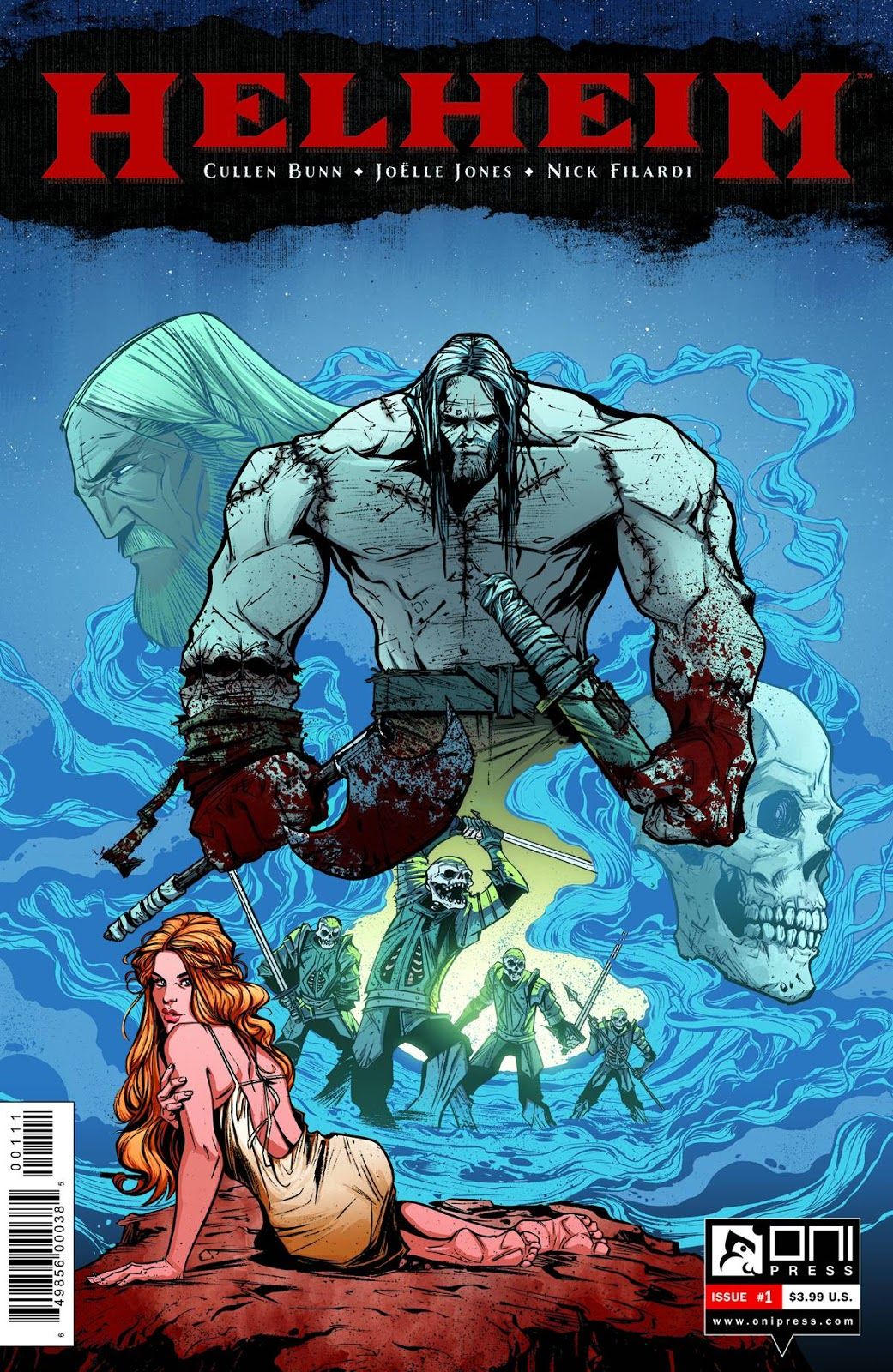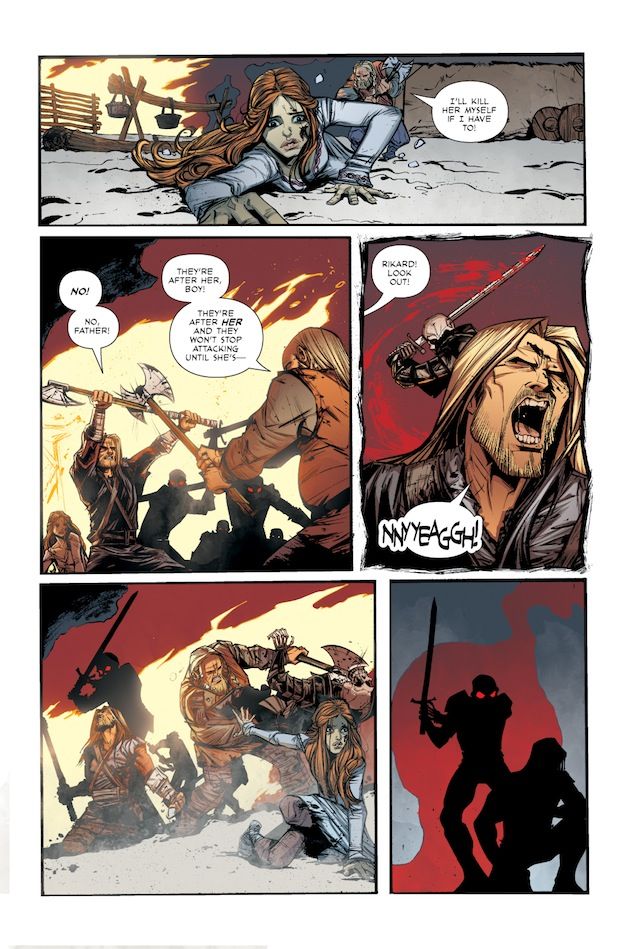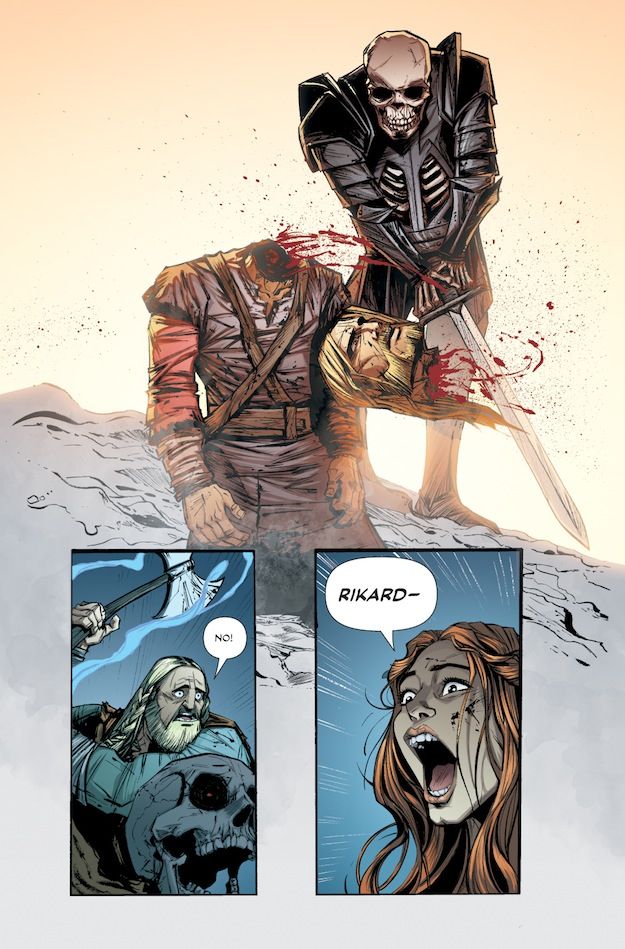One of the more exciting pieces of news to come out of New York Comic Con was that Joelle Jones and Cullen Bunn are teaming up on a Viking-themed project at Oni Press called Helheim. Bunn has a growing following thanks to The Sixth Gun as well as his work on Marvel's Captain America, Venom and Wolverine. Jones, meanwhile, has applied her expressive style mainly to young adult graphic novels, including Troublemaker and House of Night, both for Dark Horse. I talked to the two of them about how they collaborated to make the frozen world of Helheim a reality, and we have a short preview as well.
Robot 6: Can we start with a quick summary of what the story is about?
Cullen Bunn: I’ve often summarized Helheim as a Viking-era Frankenstein story with ghosts and demons. This is the story of Rikard, a noble warrior who is caught in the middle of a war between two witches. Rikard is honorable and good — a real hero.
And I kill him … brutally … about halfway through the first issue.
That’s not the end of his story, of course. Rikard is raised from the dead as a draugr — one who walks after death. He becomes a terrible weapon in the war between witches. But he soon sees what this war is costing the people around him, and he decides that the only hope he has of ever achieving peace after death… to free himself… is to destroy both the witch who killed him and the witch who brought him back from the dead.
Rikard is an engine of pure destruction, but he longs for peace. He wants the rewards of the afterlife that he’s been promised. But he questions if he’ll ever attain his final reward… and if he actually deserves it.
From the description I read, this story feels like something out of mythology. What were your sources of inspiration?
Bunn: My inspiration for Helheim comes from a variety of sources, everything from Beowulf to Mary Shelley’s Frankenstein, from the great Harryhausen flicks I grew up watching to the movie The 13th Warrior (and the Crichton novel that inspired it, Eaters of the Dead). This is another example of harvesting the memories of the things I hold dear in order to tell a story that (I hope) is uniquely my own.
How closely did the two of you work together on creating the world of the story?
Bunn: Initially, I worked alone in developing the world. This is an idea that I’ve had in my head for quite a while. I want to say that the idea for this story and the idea for my graphic novel The Tooth took shape around the same time. That said, once Joelle got involved and I saw her initial designs for characters and locales, her vision began to shape what I had in mind for the world. That’s one of the joys of working with a real talent like Joelle. Her artwork propelled the story into completely different places. It got me thinking about the initial tale, the characters, and the world as a whole in a different way.
Jones: Cullen came with the story already in mind and I went off to work on the initial sketches for the characters after reading the outline for the story. The whole process of working together has been pretty seamless and really fun.
Joelle, what were you aiming for with the look of the characters and the book, and what were your inspirations?
Jones: I really wanted to draw the heavy metal book of my dreams and using a cue from Cullen I drew inspiration from some of my favorite films like Excalibur, Big Trouble in Little China and Conan. I also threw in a dash of airbrushed van art to round it out.
Joelle, Most of your work that I have seen has been aimed at teen girls (Token, House of Night, Troublemaker). This seems like a departure for you. What changes did you have to make to illustrate this kind of story?
Jones: I really had to stretch myself and get a little grungy, and I really enjoyed the challenge. This book is a lot rougher and has a lot more decapitations compared to the teen books I’ve done in the past.
Cullen, you have done a number of supernatural stories, and I know from hearing you talk at cons that you have a real love of ghosts and other characters from the dark side. What did this story allow you to do that you haven't done before?
Bunn: Unlike many of my other stories, Helheim gave me a chance to play with these supernatural elements in a much darker, much more violent world. I mean, there’s a fair amount of violence in much of my work, but Helheim takes it to an entirely new level. Helheim’s world is one of fantasy, yes, but it is a dismal, mean fantasy world, and it gives me the opportunity to play with some darker themes than in some of my previous work. I guess that’s saying a lot, considering much of my previous work revolves around demons and world-destroying six-shooters and monster-fighting teeth!
Which of the characters posed the biggest challenge for you creatively?
Bunn: In the story, you’ll meet Kirk, the father of our “hero” Rikard. He’s a tough-as-nails warrior who loves his people and loves his son. When he sees what has become of his child, his thoughts turn dark and bloody. Here we have a father who decides that the only option he has is to destroy his child. Putting aside cultural differences … putting aside the context of a supernatural story full of undead beasts … that was a tough concept for me to wrap my head around.
Jones: Rikard’s ever-changing silhouette was a challenge but mostly it came down to remembering where all the stitches on his body were, also remembering if a certain deformity is on his left or right side.
How long will this story last — is it going to be self-contained? Will Rikard find some sort of peace by the end? And do you have plans for more stories within this world?
Bunn: The initial six issues tells a complete story, but leave some room to further explore the world. After that initial arc, who knows? It will depend on the reaction to the book. There’s a much larger world to explore, I think, and I’d definitely like to do so. Rikard may or may not survive the initial storyline. Heck … He doesn’t survive the first issue. It’s tough to keep him down.
Helheim debuts in March from Oni Press.





